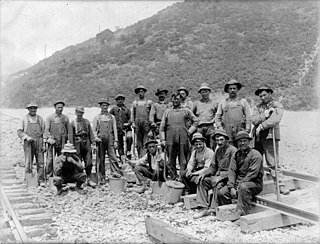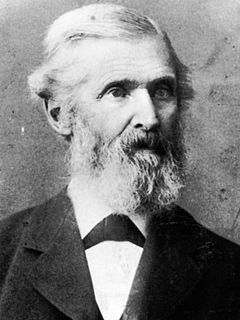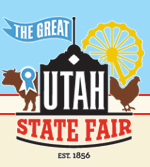
Brigham Young was an American religious leader and politician. He was the second president of The Church of Jesus Christ of Latter-day Saints from 1847 until his death in 1877. During his time as church president, Young led his followers, the Mormon pioneers, west from Nauvoo, Illinois to the Salt Lake Valley. He founded Salt Lake City and served as the first governor of the Utah Territory. Young also worked to establish the learning institutions which would later become the University of Utah and Brigham Young University. A polygamist, Young had at least 55 wives and 56 children. He instituted a ban prohibiting conferring the priesthood on men of black African descent, and led the church in the Utah War against the United States.

Millard County is a county in the U.S. state of Utah. As of the 2010 United States Census, the population was 12,503. Its county seat is Fillmore, and the largest city is Delta.

Fillmore is a city and the county seat of Millard County, Utah, United States. The population was 2,435 at the 2010 United States Census. It is named for the thirteenth US President Millard Fillmore, who was in office when Millard County was created by the Utah Territorial legislature.

The State of Deseret was a provisional state of the United States, proposed in 1849 by settlers from The Church of Jesus Christ of Latter-day Saints in Salt Lake City. The provisional state existed for slightly over two years and was never recognized by the United States government. The name derives from the word for "honeybee" in the Book of Mormon.

The Territory of Utah was an organized incorporated territory of the United States that existed from September 9, 1850, until January 4, 1896, when the final extent of the territory was admitted to the Union as the State of Utah, the 45th state. At its creation, the Territory of Utah included all of the present-day State of Utah, most of the present-day state of Nevada, much of present-day western Colorado, and the extreme southwest corner of present-day Wyoming.

The Salt Lake City Council Hall is currently home to offices of the Utah Office of Tourism and the Utah Film Commission and is located on Capitol Hill in Salt Lake City, Utah. Built in 1864-66, the building is historically important as the Old Salt Lake City Hall or just Old City Hall from 1866 to 1894. It was designated a National Historic Landmark in 1975, as an emblem of the conflicts between the governments of the Utah Territory and the United States in the 19th century.

The Liberal Party was a political party established in the latter half of the 1800s in Utah Territory before the national Democrats and Republicans established themselves in Utah in the early 1890s.

Cove Fort is a fort, unincorporated community, and historical site located in Millard County, Utah. It was founded in 1867 by Ira Hinckley at the request of Brigham Young. One of its distinctive features is the use of volcanic rock in the construction of the walls, rather than the wood used in many mid-19th-century western forts. This difference in construction is the reason it is one of very few forts of this period still surviving.

Martha Maria "Mattie" Hughes Cannon was a Utah State Senator, physician, Utah women's rights advocate, suffragist, polygamous wife, and a Welsh-born immigrant to the United States. Her family immigrated to the United States as converts to The Church of Jesus Christ of Latter-day Saints and traveled West to settle in Utah territory with other Saints. She started working at the age of fourteen. At sixteen she enrolled in the University of Deseret, now called the University of Utah, receiving a Bachelors in Chemistry. From there she attended the University of Michigan and received her MD. She became the fourth of six wives in a polygamous marriage to Angus M. Cannon, a prominent Latter-day Saint leader during the anti-polygamy crusade. Cannon exiled herself to Europe so she wouldn't have to testify against her husband. Upon returning to Utah, Cannon worked as a doctor and fought for women's rights. She helped put women enfranchisement into Utah's constitution when it was granted statehood in 1896. On November 3, 1896 Cannon became the first female State Senator elected in the United States, defeating her own husband, who was also on the ballot. Martha Hughes Cannon was the author of Utah sanitation laws and was a founder and member of Utah's first State Board of Health.

The Utah State Capitol is the house of government for the U.S. state of Utah. The building houses the chambers and offices of the Utah State Legislature, the offices of the Governor, Lieutenant Governor, Attorney General, the State Auditor and their staffs. The capitol is the main building of the Utah State Capitol Complex, which is located on Capitol Hill, overlooking downtown Salt Lake City.

Truman Osborn Angell was an American architect who served many years as the official architect of The Church of Jesus Christ of Latter-day Saints. The brother-in-law of Brigham Young, he was a member of the vanguard company of Mormon pioneers that entered the Salt Lake Valley on July 24, 1847. He designed the Salt Lake Temple, the Lion House, the Beehive House, the Utah Territorial Statehouse, the St. George Utah Temple, and other public buildings. Angell's modifications to the Salt Lake Tabernacle are credited with perfecting the acoustics for which the building is famous.

The Utah State Legislature is the state legislature of the U.S. state of Utah. It is a bicameral body, comprising the Utah House of Representatives, with 75 state representatives, and the Utah Senate, with 29 state senators. There are no term limits for either chamber.

The History of Utah is an examination of the human history and social activity within the state of Utah located in the western United States.

John Riggs Murdock was the leader of the most Mormon pioneer down-and-back companies in Latter-day Saint history, leading ox-drawn wagon trains that carried both merchandise and passengers "down and back" from Missouri to Utah.
The "Runaway Officials of 1851" were a group of three federal officers, Judge Perry Brocchus, Judge Lemuel Brandenbury, and Territorial Secretary Broughton Harris, who were appointed to Utah Territory by President Millard Fillmore in 1851. These men arrived in Utah in the summer of that year, and though they were cordially welcomed, they soon came into conflict with The Church of Jesus Christ of Latter-day Saints and Latter-day Saint settlers of the territory. The confrontation centered around several features of the Mormon pioneer community, most significantly their practice of polygamy, which the appointees publicly denigrated. Eventually disagreements over territorial administration became rampant between the non-Mormon federal officials and newly appointed territorial Governor and President of the LDS Church, Brigham Young. By the end of September 1851, each of these officers left his Utah appointment for the east and their posts remained unfilled for the next two years. This was the first in a series of disagreements between the Latter-day Saint residents of Utah Territory and the United States government which would finally result in the Utah War of 1857–1858.

The following is an alphabetical list of articles related to the U.S. state of Utah.

Edwin Dilworth Woolley, Sr. was a Mormon pioneer, an early Latter-day Saint bishop in Salt Lake City, and a businessman in early Utah Territory who operated mills.

The Council House, often called the State House, was the first public building in Utah; being constructed in 1849–50. The building stood in Salt Lake City, Utah Territory, on the corner of Main Street and South Temple Street. On June 21, 1883 the building was destroyed when a neighboring wagon depot caught fire and several barrels of gunpowder exploded, spreading the fire to the Council House.

The Utah State Fair is held at the Utah State Fairpark in Salt Lake City, Utah, United States. The fairgrounds are listed on the National Register of Historic Places. The fair takes place each year starting on the first Thursday after Labor Day and lasts for 11 days.

Early in its history, The Church of Jesus Christ of Latter-day Saints had a series of negative encounters with the United States federal government. This led to decades of mistrust, armed conflict, and the eventual disincorporation of the church by an act of the United States Congress. The relationship between the church and the government eventually improved, and in recent times LDS Church members have served in leadership positions in Congress and held other important political offices. The LDS Church becomes involved in political matters if it perceives that there is a moral issue at stake and wields considerable influence on a national level with over a dozen members of Congress having membership in the church in the early 2000s, and about 80% of Utah state lawmakers identifying as Latter-day Saints.
























